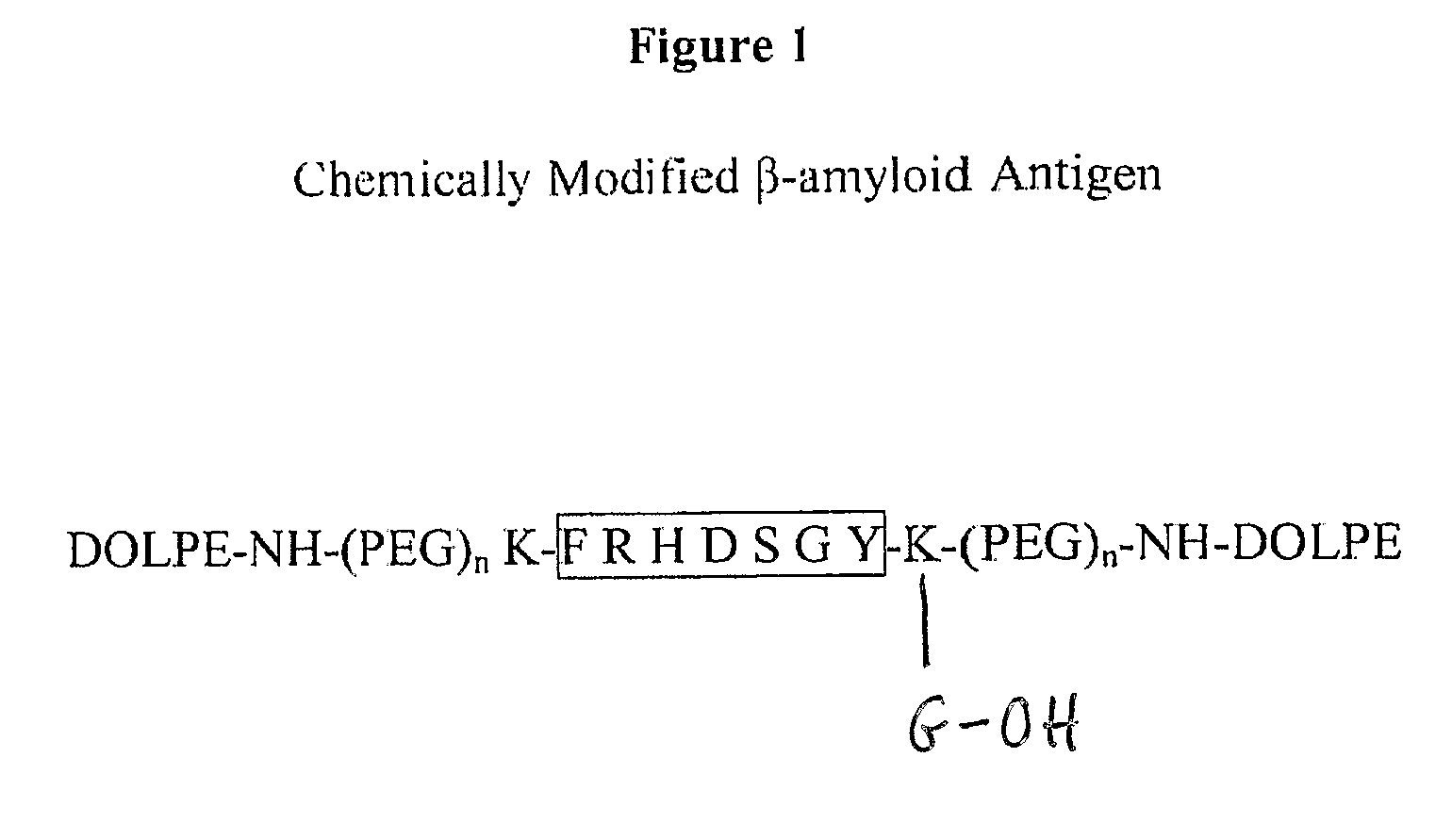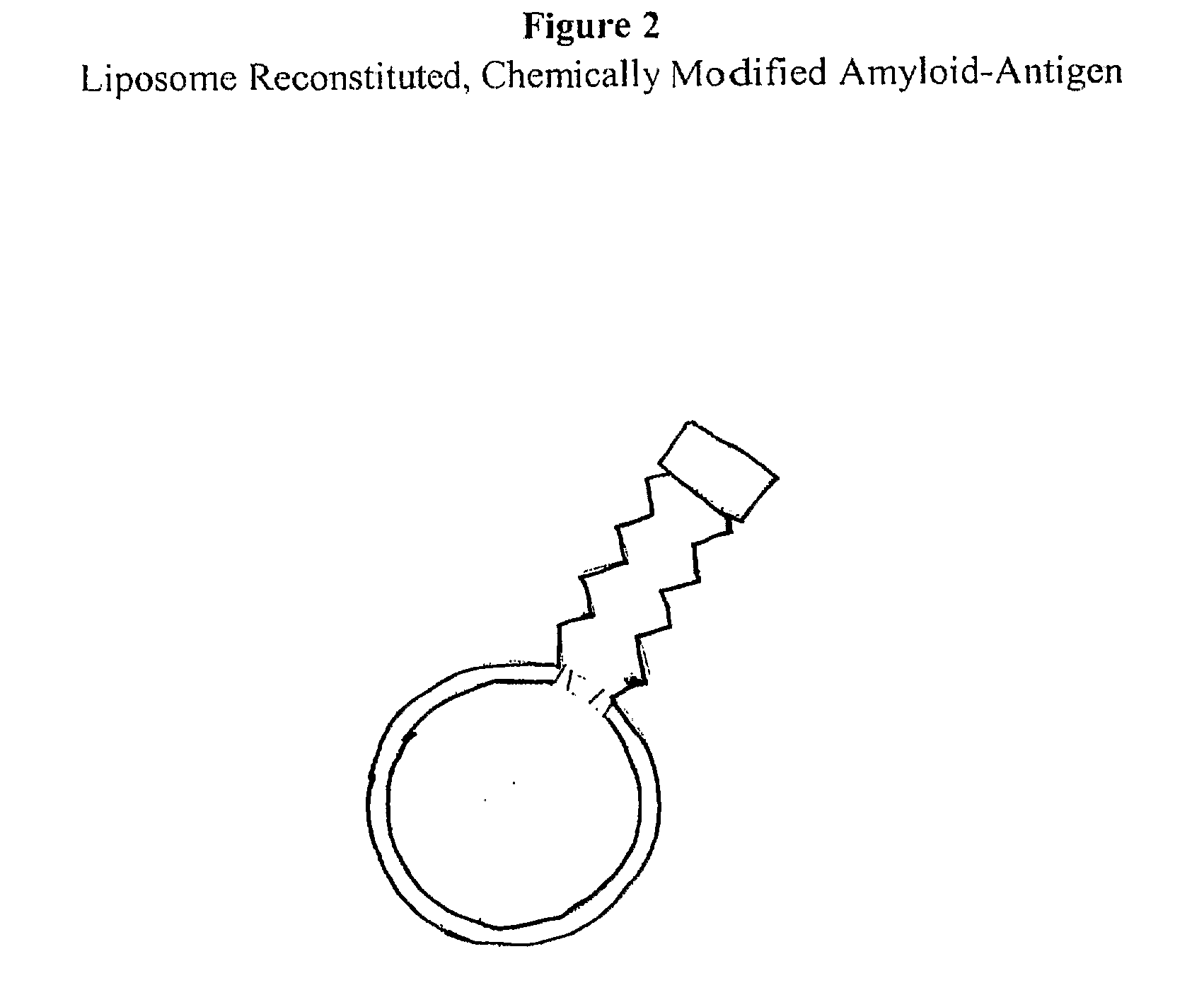Methods And Compositions Comprising Supramolecular Constructs
a technology of supramolecular constructs and compositions, applied in immunological disorders, antibody medical ingredients, peptide sources, etc., can solve the problems of inability to solve simple math problems, inability to produce specific desired responses, and inability to meet the needs of individuals,
- Summary
- Abstract
- Description
- Claims
- Application Information
AI Technical Summary
Benefits of technology
Problems solved by technology
Method used
Image
Examples
example 1
[0159] The present inventors demonstrated that neuronal death occurs from chronic exposure of primary rat hippocampal cultures to micromolar concentrations of a peptide corresponding to residues 106-126 of the amino-acid sequence deduced from human PrPc cDNA, in a concentration dependent manner. The data are shown in Table 1.
TABLE 1Chronic treatment of hippocampal neurons for 9 dayscell death %Peptide20 μm80 μmPrP 106-12618 ± 8 100 ± 8 PrP 57-640 ± 53 ± 4PrP 89-1065 ± 22 ± 6PrP 106-1140 ± 312 ± 6 PrP 127-1353 ± 615 ± 9 PrP 127-1471 ± 718 ± 7 PrP 106-126 scrambled3 ± 28 ± 3
[0160] The data are the means±s.e. of 6-10 determinations and are normalized to the toxic effect of PrP106-126 (designated 100% response).
[0161] It was shown that the neuronal death induced by PrP 106-126 occurred by apoptosis in a dose dependent manner. In the terminal stages of subacute encephalopaties, such as scrapie, PrPSc reaches at whole brain concentrations 10 to 20 times higher than PrPc, which resemble...
example 2
Methods for Making Supramolecular Antigenic Constructs
[0163] The supramolecular constructs described herein were uniquely synthesized using standard Fmoc / tBu amino acid side-chain protections. Peptides which are modified at both the C- and N-terminus by a PEG-lipid moiety have not previously been reported. Typically, pegylation of peptides results in mixtures of regioisomers. The inventors herein demonstrate a convenient method for the site-specific attachment of a PEG-lipid conjugate to both the C- and N-terminus of Aβ using partially protected peptides.
[0164] For those peptide sequences containing internal Lys or His residues (4-11, 1-16, 22-35), an orthogonally protected Lys(ivDde) was added to each termini. An additional Gly was added to the C-terminal to facilitate synthesis. The Fmoc group was removed with 20% piperidine in DMF and N-acetylated using acetic anhydride. Selective cleavage of the ivDde groups was achieved with 3% hydrazine hydrate in DMF for one hour. The 2-chl...
example 3
Comparison of Immunogenicity of PEGylated and Palmitoylated antigens, ELISA and Disaggregation Assays
[0166] Liposomal antigens were prepared as described above. The sequences PEG-Aβ1-16, -Aβ4-11 and -Aβ22-35 were reconstituted in a construct consisting of liposomes made of dimyristoyl phosphatidyl choline (DMPC), dimyristoyl phosphatidyl ethanolamine (DMPEA), dimyristoyl phosphatidyl glycerol (DMPG) and cholesterol (0.9: 0.1: 0.1: 0.7 molar ratios) containing monophosphoryl lipid A (40 mg / mM phospholipids).
ELISA
[0167] The antigens and palmitoylated Aβ1-16 were used for the immunization in C57BL / 6 mice in 2 week intervals. 10-12 animals were immunized with each antigen. Sera were taken 5 days after the boostings and ELISA were conducted with several dilutions of the sera. Comparative results showing the immunogenicity of the different antigens are presented in FIG. 7.
[0168] The ELISA data showed that liposomal PEG-Aβ1-16 is significantly more immunogenic than palmitoylated A621-...
PUM
| Property | Measurement | Unit |
|---|---|---|
| incubation time | aaaaa | aaaaa |
| size | aaaaa | aaaaa |
| size | aaaaa | aaaaa |
Abstract
Description
Claims
Application Information
 Login to View More
Login to View More - R&D
- Intellectual Property
- Life Sciences
- Materials
- Tech Scout
- Unparalleled Data Quality
- Higher Quality Content
- 60% Fewer Hallucinations
Browse by: Latest US Patents, China's latest patents, Technical Efficacy Thesaurus, Application Domain, Technology Topic, Popular Technical Reports.
© 2025 PatSnap. All rights reserved.Legal|Privacy policy|Modern Slavery Act Transparency Statement|Sitemap|About US| Contact US: help@patsnap.com



